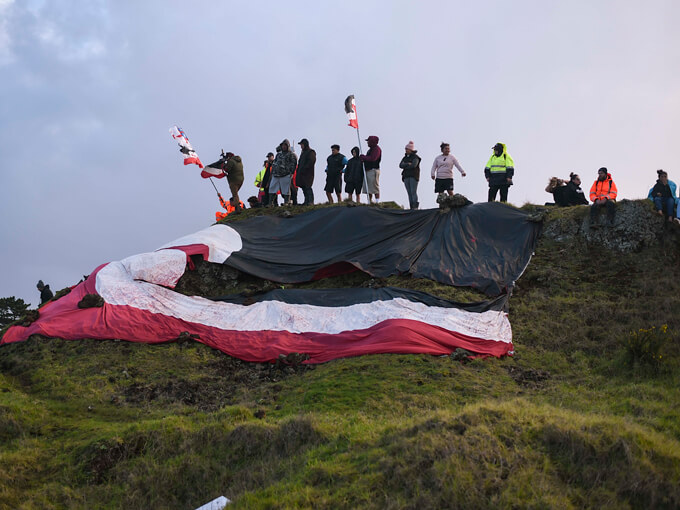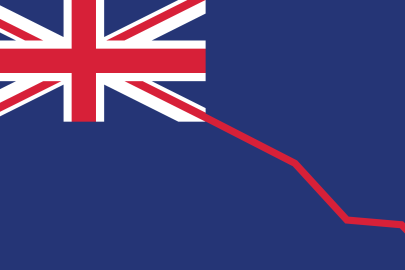Sep 19, 2019 Politics
The land at Ihumatao cannot be settled within the treaty framework – but no one is asking for that, writes Morgan Godfery.
Did you know this country’s founding document is the New Zealand Settlements Act 1863? I know the popular answer is the Treaty of Waitangi, but perhaps a better answer is the legislation that made raupatu — land confiscations — and European settlement possible. The 19th-century statute made our pastoral tradition possible, the land stolen in its name hosts our suburban sprawl, and the agricultural and industrial economy it supports feeds our growing population. I mean, what is “New Zealand” without the formerly Maori land that underpins its wealth and prosperity?
Polite people understand this is the kind of question best left unsaid. Or at least left for the Waitangi Tribunal. And it’s one reason why everyone from Prime Minister Jacinda Ardern to Opposition leader Simon Bridges are dancing around the central fact at Ihumatao. The Prime Minister says the occupation at the South Auckland headland is an intra-iwi issue. The solution is for “mana whenua” to find. The National Party leader says the protest is interfering with Fletcher Building’s “property rights”. The troublemakers should up sticks and let the 480-home development move ahead.
“Mana whenua”. “Property rights”. It’s all close, and yet so far away from the heart of the matter: Ihumatao is stolen land.
The only political leader with the courage to admit as much is Green Party co-leader Marama Davidson, mostly because she’s one of the few politicians keen on its consequence. That is, if land was stolen — as Ihumatao was — it should return to its rightful owners at the first opportunity. But that moral and ideological admission would force the Prime Minister, were she to make it, into an almost impossible position. Nothing short of return and preservation will move the hundred or so land protectors off the old Wallace family block. But any crown purchase with the aim of doing so would explicitly or implicitly acknowledge the crown owe Maori a right of return of one kind or another.
This is probably fine so far as Ihumatao goes — a mere 82 acres — but what does it mean for the other 1.2 million acres taken under the New Zealand Settlement Act? I suspect the question is putting the spooks up the Prime Minister’s office. And it’s probably why one of Ardern’s Ministers, the Tamaki Makaurau MP Peeni Henare, told The Nation, “If the government steps in to buy this land back, we undermine every treaty settlement that’s been done to date.” In other words, returning one acre means re-examining the other 1,199,999 acres. Does a win at Ihumatao mean open season on Waikato dairy farms?
Of course not. But the fear is that Ihumatao and every other inch of private land could form part of that limitless drawing account otherwise known as Maori privilege. Conservative writer Karl Du Fresne fears government intervention on the land protectors’ side could set “a dangerous precedent”. In another case and in another time, that point might have had something to it. But what distinguishes Ihumatao from, say, Bastion Point is the unusual and generous ask. The land protectors aren’t asking for the land to return to “iwi” per se. The land is “nationally significant”, kaitiaki-in-chief Pania Newton argues, and she and her supporters are calling for it to form part of the national estate in one form or another.
No one is asking for a treaty settlement or a treaty solution. It’s either ignorant or dishonest for the government to suggest otherwise. Instead, the land protectors are asking for a commercial solution. There are two possibilities: the crown can enter negotiations with Fletcher Building, purchasing the land at market price; or Waikato-Tainui, the wealthiest iwi with whakapapa at Ihumatao, can enter negotiations with the construction giant and settle a deed of sale. Fletcher Building walks away with the W, recovering its investment (and maybe a bit more), and the land protectors return home sharing stories from the most significant struggle for Maori land in the 21st century.
Great! Except the expectation Waikato-Tainui should front up with the cash is absolutely scandalous. Why should iwi buy back the very land stolen from them in the first place? It’s like paying the burglar to give back your laptop. In treaty settlements — the base of Waikato-Tainui’s billion-dollar wealth — iwi accept redress in land and cash worth less than 5% of what was originally taken. So settlements aren’t acts of crown charity — they’re a gift from iwi to New Zealand. The settling iwi agree to renew their relationship with the crown for, let’s be honest, next to nothing. Why do we expect iwi to give even more?
That leaves a crown purchase at Ihumatao as not necessarily the last but certainly the best option. In the 1990s, the government came up with $4.7 million to acquire the Otuataua Stonefields, the reserve right next door to occupied land at Ihumatao. What’s the difference between the Stonefields purchase and a further purchase today? Qualitatively, not much. Quantitatively, a little bit more. Think in the tens of millions this time. And perhaps that brings us to the heart of the matter for the government. Price. Never mind “full and final settlements” or even confiscation and its possible precedents. The government and Waikato-Tainui are playing pass the parcel and hoping the music never stops.
This piece originally appeared in the September-October 2019 issue of Metro magazine, with the headline “Pass the parcel”.






